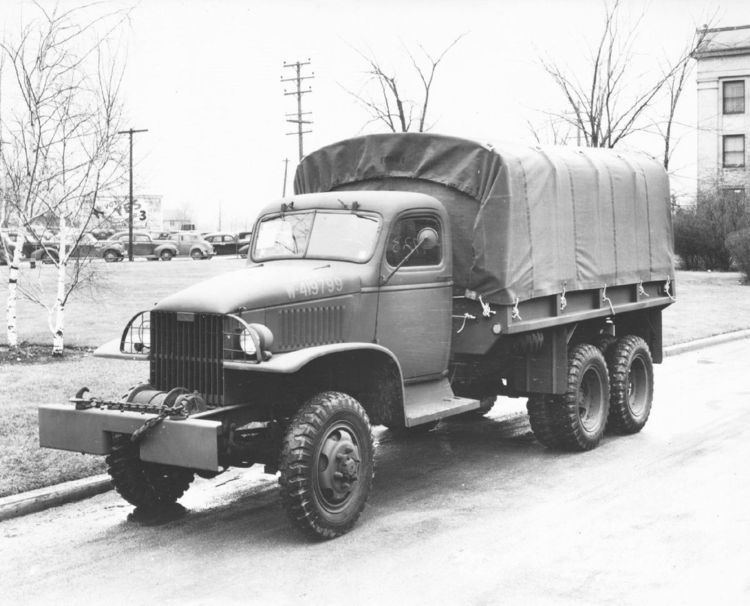Place of origin United States No. built 562,750 | Produced 1941–45 | |
 | ||
Type 2 ⁄2-ton 6×6 Cargo truck Designer Yellow Truck and Coach Co. Manufacturer Yellow/GMC Truck and Coach
Chevrolet | ||
The GMC CCKW was 2½-ton 6x6 U.S. Army cargo truck that saw heavy service in both World War II and the Korean War. The original "Deuce and a Half", it formed the backbone of the famed Red Ball Express that kept Allied armies supplied as they pushed eastward after the Normandy invasion.
Contents
The CCKW came in many variants, including open or closed cab, long wheel base (LWB 353) and short (SWB 352), and over a score of specialized models. It began to be phased out with the deployment of the 6×6 M35 in 1950, but remained in active U.S. service until the mid-1960s. It is related to the Chevrolet G506, built at the same factory.
History
In 1939-1940 the US Army Ordnance Corps was developing 2 1⁄2-ton (2,268 kg) load-rated 6×6 tactical trucks that could operate off-road in all weather. General Motors, already supplying modified commercial trucks to the Army, modified the 1939 ACKWX - built for the French Army - into the CCKW. The General Motors design was chosen by the Army and went into production at GM'S Yellow Truck and Coach division's Pontiac, Michigan plant alongside 6×4 CCWs. Later they were also manufactured at GM's St. Louis, Missouri Chevrolet plant.
The name CCKW comes from GMC model nomenclature:
By the end of production in 1945, 562,750 CCKWs in all variants had been built, a total second only to the “Jeep”.
Engine and drive-line
The CCKW was equipped with the GMC 270 engine, an overhead valve I6 with 91 horsepower (68 kW) at 2750rpm and 216 pound force-feet (293 N·m) at 1400rpm. A 3 25⁄32 in (96 mm) bore by 4 in (102 mm) stroke gave a 269.5 cu in (4.4 L) displacement. This engine was designed for commercial trucks, and was reliable in service.
The transmission was a Warner T93 5-speed with a direct 4th gear and overdrive 5th gear. The transfer case had high and low gears, and engaged the front axle. Originally all axles were a Timken split type, later trucks also used GM "banjo" types.
Chassis
The CCKW had a ladder frame chassis with three driven beam axles, the front on leaf springs, the rear tandem on leaf springs with locating arms. There were two wheelbases, the short Model 352 and the long Model 353. The short, 145 in (368 cm) (Measurements are from the centerline of the front axle to the centerline of rear bogie) was used with a short cargo bed as an artillery prime mover for 75mm and 105mm howitzers. All other models used the long 164 in (417 cm) wheelbase. Tires were 7.50-20, brakes were hydraulic with vacuum assist.
Some were fitted with 10,000 lb (4,500 kg) front-mounted winches. A winch added 300 pounds (140 kg) and 14 inches (36 cm).
Some open cab chassis were cut in half behind the cab for air transport. Each half was a load, at the vehicle's destination, the halves were bolted back together.
Versions
Initially, all versions used a modified commercial closed cab design having a metal roof and doors. By 1944 an open cab version, with a canvas roof and doors, was used. This was easier to build, and the roof could be removed to lower the shipping height. 1 in 4 of cabs had a machine gun mounting ring above the co-driver's position.
The CCKW provided a platform for the widest range of bodies on any U.S. military vehicle, with the 12 ft (3.7 m) cargo version being the most common. As steel was more heavily rationed during the course of the war, the steel cargo bed was replaced by a wooden one. Wooden beds proved unsatisfactory and a 'composite' bed with steel sides, framing, and wooden bottom slats was developed. However, the composite bed was still unsatisfactory and the bed design returned to all steel.
A standard rectangular van configuration was used in communications, medical, workshop, and many other specialty roles. Special built vans were also used.
Specialized variants
Many specialized variants of the basic 6×6 CCKW were made, some in small numbers, including some converted in the field. These include:
AFKWX
The AFKWX (A for 1939, F for forward cab, K for all wheel drive, and W for tandem rear axles) 353, a cab over engine cargo bed version of the CCKW, went into production alongside it in 1942 at Yellow’s Pontiac plant and Chevrolet’s in St. Louis. Otherwise mechanically identical, its compact cabin design allowed a 15 ft (4.6 m), and later 17 ft (5.2 m) cargo bed to be fitted. The first 50 produced had closed cabs, all others were open. The cab over design made engine maintenance difficult. As a result, only 7235 were built, none with a front-mounted winch.
CCW
The CCW (C for 1941, C for conventional cab, and W for tandem rear axles), an on-road, 5-ton 6×4 truck version of the CCKW that lacked only its front wheel drive. A beam front axle was used, with the transfer case locked in high range.
DUKW
The DUKW (D for 1942, U for utility, K for all wheel drive, and W for tandem rear axles) (“Duck”) was an amphibious truck that shared the CCKW's driveline. First produced at Yellow’s Pontiac plant, as demand increased production was added to Chevrolet’s St. Louis plant. The hull, designed by an America's Cup winner, had excellent sea-keeping abilities. A very successful design, 21,147 were built.
